Maharshi Adhyatma Vishwavidyalay conducts novel spiritual research using UAS (Universal Aura Scanner)
|
Corals have a pride of place among the nine astrological gemstones (or Navaratnas). The use of corals as gemstones is said to have begun before recorded history. Unlike most other gemstones which are of mineral origin, corals (like pearls) are organic – obtained from marine animal. Corals are the external skeleton of tiny, plant-like marine animal called the coral polyps. When these polyps die, they leave behind hardened skeleton composed primarily of calcium carbonate. This leftover skeleton is what is used as gemstones. Thus, the term coral can refer to the animal as well as its skeletal remains. In addition to their value as jewellery, corals are also valued in other fields such as astrology, medicine and healing. However, for complete benefit, they need to be worn with correct spiritual knowledge. For this reason, we have shared a few less known, but important spiritual attributes of corals. This will help readers to select the right kind of coral gemstones for spiritual benefit. |
1. Place of origin : Corals are obtained from various countries such as Japan, Italy, Taiwan, Australia, India. Countries such as China are popular for cutting corals into different shapes. Astrologers prefer Japanese or Italian corals, as according to them they provide better results. However, compared with other countries, India is more sattvik (Spiritually pure). Hence, corals found in India are more beneficial from the spiritual perspective. This is followed by Japan (medium sattvik corals) and Italy (less sattvik corals).
2. Types : Among the many types of corals that grow under the sea, on the basis of their chemical composition and colours, they are primarily of two types.
2A. Calcareous : These comprise primarily of calcite and are predominantly white, red or pink. They are most often used in astrology and jewellery.
2B. Conchiolin : These comprise primarily of conchiolin, the same organic protein found in pearls and other shells. They are tougher and less brittle than the calcareous type. These are brown, black, golden or rarely blue. Despite their non-sattvik colours – brown and black – conchiolin corals are spiritually more beneficial as compared to the calcareous corals. This is because conchiolin protein is sattvik.
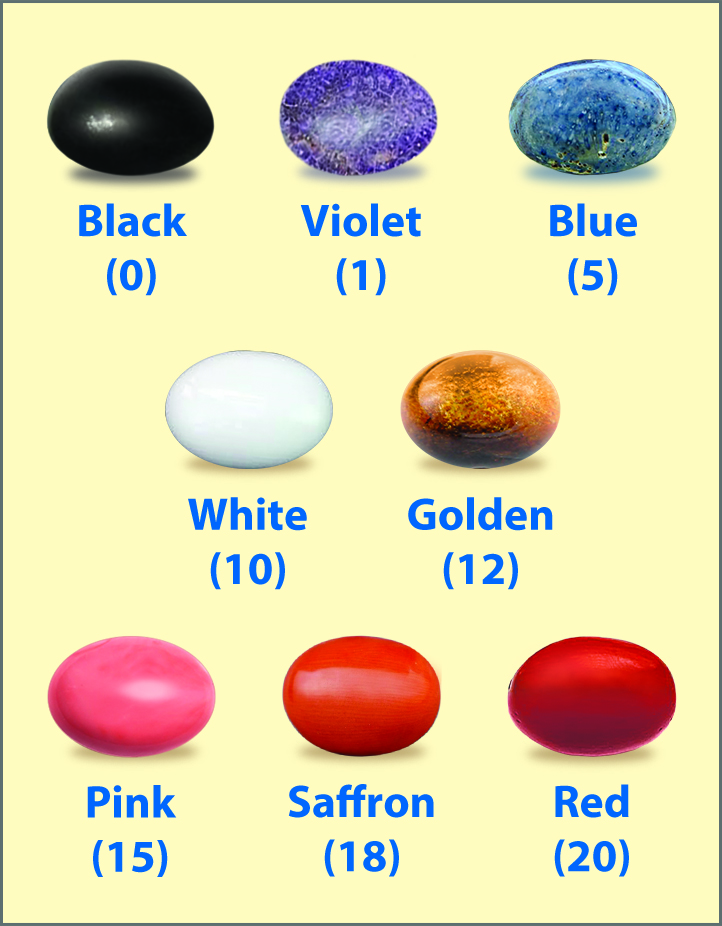 3. Colour : Corals are available in shades of white, pink, saffron, red, blue, violet, gold and black. However, in the jewellery industry, primarily red, pink and white are used. To ensure good quality, the traders check for the stone’s uniformity in colour without any secondary tone throughout the surface. Of all the colours, the red coral (sometimes called ‘Ox blood’ in the trade) is the most expensive. This is because of its high demand in the jewellery industry due to its significance from the perspective of astrology.
3. Colour : Corals are available in shades of white, pink, saffron, red, blue, violet, gold and black. However, in the jewellery industry, primarily red, pink and white are used. To ensure good quality, the traders check for the stone’s uniformity in colour without any secondary tone throughout the surface. Of all the colours, the red coral (sometimes called ‘Ox blood’ in the trade) is the most expensive. This is because of its high demand in the jewellery industry due to its significance from the perspective of astrology.
According to the science of astrology, the vibrations of the Mangal Graha (Mars) are attracted to a larger extent in red coral gemstones. This is why, the wearer obtains the blessings of this Graha. (Please note that the word ‘Graha’ as described in astrology goes beyond the meaning of the word ‘Planet’. It describes the ability of celestial events to either influence or predict events on earth). Red corals are predominantly associated with the Tejtattva (Absolute Fire Principle) and Apatattva (Absolute Water Principle). The maximum possible spiritual benefit that can be obtained by wearing a gemstone is 20 per cent. The colours of corals and their respective spiritual benefit in percentage is given here.
4. Clarity : In general, the more clarity and smoothness in a gemstone, the more it will be able to attract and emit the vibrations of the Graha associated with it. Coral is generally an opaque gemstone. Hence, any dents, cracks, stains, black linings or spots are visible clearly on its surface (as shown here). This can seriously affect a coral’s quality besides reducing its spiritual value. Hence, the more clear, smooth and spotless the surface of the coral, the more the spiritual benefits obtained from it.
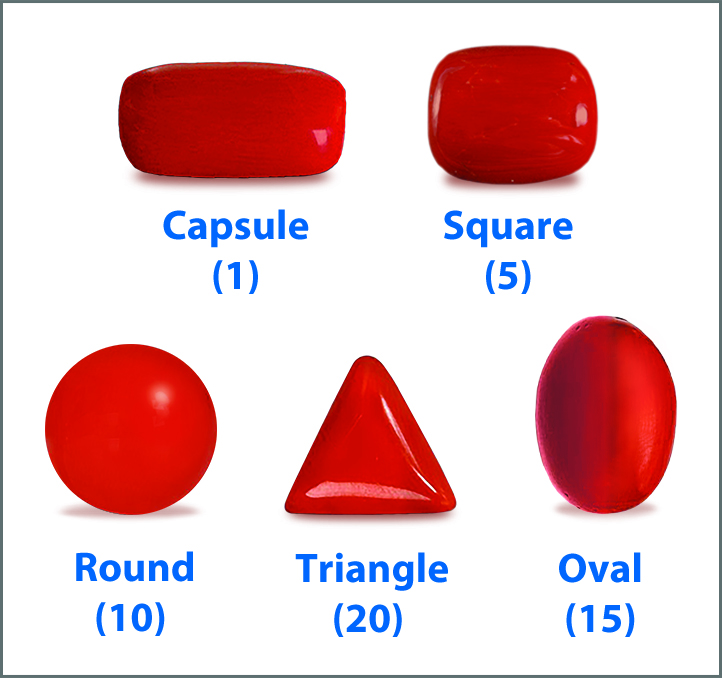 5. Cut : Unlike most other gemstones, corals are quite soft and brittle with a hardness of around 3.5 on the Mohs Scale. This means that they are available in fewer shapes and cuts as compared to other gemstones. Most popular shapes of corals are triangular, square, round, oval and capsule. Oval and triangular shapes are more expensive. When considered from the spiritual perspective, triangular is most beneficial for a coral ring. This is because this shape is related to Ichchashakti (Cosmic Energy of will) which is activated in Mangal Graha. Hence, it can attract the vibrations of this Graha the most (20 per cent) and provide benefits accordingly. The spiritual benefit in percentage from various shapes of corals can be understood from the picture given ahead.
5. Cut : Unlike most other gemstones, corals are quite soft and brittle with a hardness of around 3.5 on the Mohs Scale. This means that they are available in fewer shapes and cuts as compared to other gemstones. Most popular shapes of corals are triangular, square, round, oval and capsule. Oval and triangular shapes are more expensive. When considered from the spiritual perspective, triangular is most beneficial for a coral ring. This is because this shape is related to Ichchashakti (Cosmic Energy of will) which is activated in Mangal Graha. Hence, it can attract the vibrations of this Graha the most (20 per cent) and provide benefits accordingly. The spiritual benefit in percentage from various shapes of corals can be understood from the picture given ahead.
7. Some tips to obtain benefits from corals as per astrology
7A. Benefits from corals : As per the science of astrology, the wearer of red corals obtains the grace of Mangal Graha. If a person with unfavourable position of Mangal in his horoscope (Mangal-dosha) or a weak Mangal wears red corals, his worldly obstacles such as difficulty in getting married, relationship issues with spouse, illness and professional hurdles get removed or reduce and his mind becomes fearless.
7B. Day to begin wearing coral jewellery : Since Tuesday is associated with the Mangal Graha, its subtle vibrations are attracted to earth the most on this day. Hence, for spiritual benefit, take up wearing of coral jewellery on a Tuesday, 1 hour after sunrise after performing the proper ritual as per the advice of an expert astrologer.
7C. Jewellery that will give maximum benefit : Corals come studded in various pieces of jewellery such as earrings, necklaces, bracelets, rings, brooches.
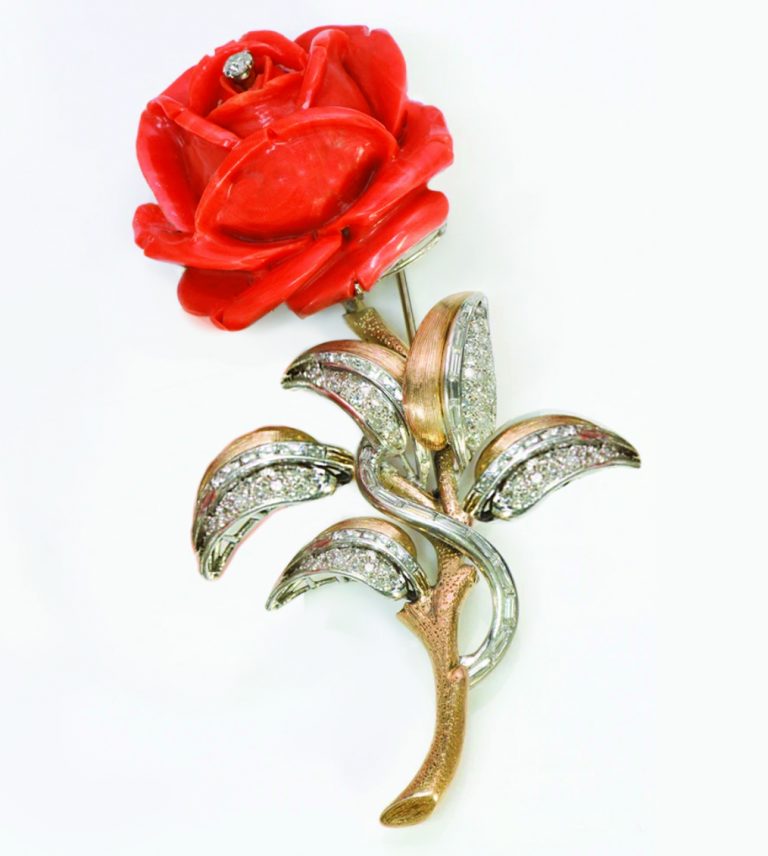

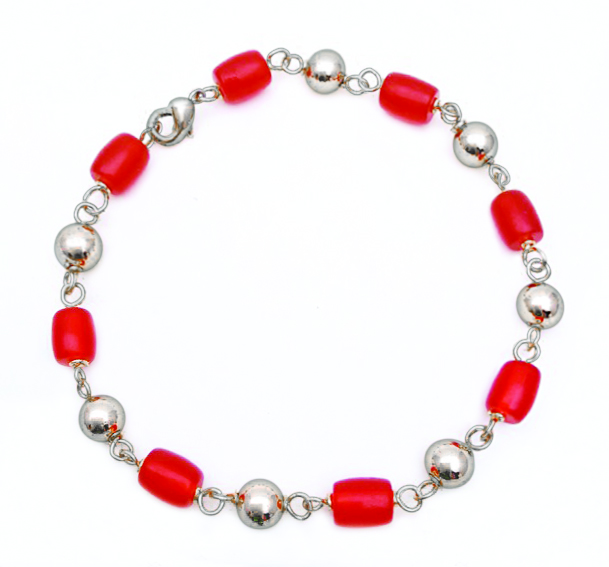
Among the various jewellery items, wearing a gemstone in a ring is most beneficial. This is because a gemstone embedded in a ring touches the body the most. This is why, the wearer can benefit to the highest extent (20 per cent) as compared to other jewellery. Coral ring has the ability to generate sattvikata in the thoughts and actions of one who wears it.
7C 1. Metal to be used : Use either gold or silver for a coral ring.
7C 2. Which finger to wear it on ? : Men should wear a coral on the ring-finger of their right hand, while women should wear it on the ring-finger of their left hand.
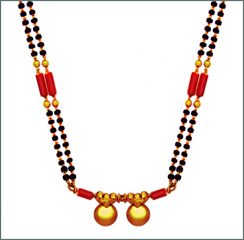 7D. Mangalsutras with corals : Corals are especially known to improve marital bliss. This is why, mangalsutra studded with coral beads is commonly worn by married women in certain parts of Goa and Karnataka.
7D. Mangalsutras with corals : Corals are especially known to improve marital bliss. This is why, mangalsutra studded with coral beads is commonly worn by married women in certain parts of Goa and Karnataka.
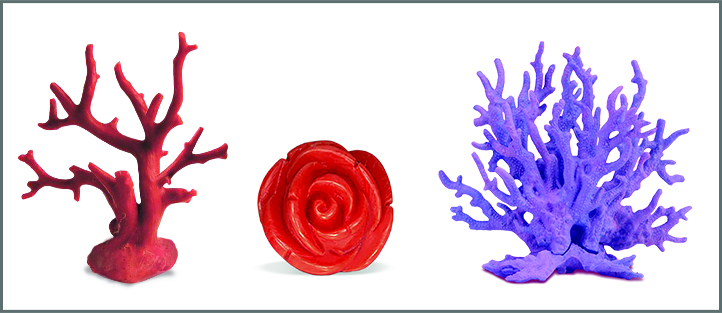 7E. Avoid combinations of gemstones : Do not wear a combination of gemstones such as red corals with diamonds, blue sapphires and emeralds. Wear one gemstone at a time. A combination of gemstones associated with different Grahas with different vibrations can be detrimental to the wearer. If the need arises, take advice from an expert astrologer.
7E. Avoid combinations of gemstones : Do not wear a combination of gemstones such as red corals with diamonds, blue sapphires and emeralds. Wear one gemstone at a time. A combination of gemstones associated with different Grahas with different vibrations can be detrimental to the wearer. If the need arises, take advice from an expert astrologer.
8. Corals as ornamental plants and sculptures : Corals grow under the sea in beautiful colours and shapes. The colourful branches of corals are kept in homes in their natural forms for ornamental purposes. Sometimes, they are used for carvings and sculpted into artistic pieces such as flowers for pins and brooches or simply stranded into necklaces with coral branches dangling from them. However, despite the beauty and sattvikata of corals, since the shape of coral branches is not sattvik, such art pieces also have less sattvikata and provide spiritual benefits to a lesser extent. Only sattvik sculptures, such as a rose, are spiritually beneficial.
9. Corals in medicine : Corals are used for various medicinal purposes such as in treatment of cancer, AIDS, and bone grafting. In Ayurveda, the ‘Praval Bhasma’ obtained from corals is used in treating various bone metabolic disorders associated with calcium deficiency.
From the spiritual perspective too, consuming corals in this manner is beneficial for the patient. This is because since the coral polyps are sattvik animals, their skeletons are also sattvik. By consuming corals, sattvikata increases, thus increasing immunity and will-power. Hence, we can consume corals for various illnesses as per the advice of an ayurvedic doctor.
10. Coral alternatives : Since coral harvesting is strictly regulated worldwide, naturally derived corals are becoming increasingly rare. Hence, alternatives such as their imitations are on the rise. These include glass, ceramics, various plastics, bones, marbles and dyed limestone.
Corals are also sometimes ‘reconstructed’ by joining small bits and pieces of various corals together using adhesives followed by dyeing uniformly. They look quite like natural corals from the structural point of view. However, from the spiritual viewpoint, imitations or any artificial coral gemstones have less sattvikata as compared to those found naturally. Hence, wearing such alternatives does not provide spiritual benefits.
11. Treatments to enhance appearance of corals : To increase market value, natural or artificial corals are often treated with various dyes, bleaches, polymers, etc. The light-colour corals are dyed in darker hues while black corals are bleached to produce golden corals. Other treatments are done to enhance the appearance of inferior quality corals by hiding their surface blemishes and filling cracks, making them smoother and more comfortable to wear.
From the spiritual perspective, even if the colour of the coral is not attractive enough or does not meet high commercial standards, in its natural form it still provides higher spiritual benefits. However, minor treatments done to make the colour attractive can be beneficial, as then the sattvikata of the corals is retained.
12. Some interesting aspects about corals
12 A. Warn about impending ill health : It is believed that the red coral, studded in a ring, warns the wearer of impending ill health by changing its colour. This is true, as coral absorbs the distressing vibrations being emitted by the body of the wearer in the period before obvious ill health. Coral also emits sattvik vibrations into the wearer’s body. This changes the colour of the worn coral, which can be a signal for the wearer of his impending ill health.
12B. Protects wearer from the evil eye : Coral is worn in certain regions of the world, such as Italy, with the belief that it protects the wearer from the evil eye. This is correct, as Mangal Graha is known for its aggressive nature. Hence, these vibrations are attracted and activated into the worn coral. This is followed by emission of waves of Shakti (Divine Energy) from the gemstone which protect the wearer from negative energies. Thus, the wearer is protected from the evil eye.
12C. Red sponge coral : Among the many varieties of coral gemstones, there is one ‘Red sponge coral’ variety which is very popular, especially in the USA.
This coral type is known to be associated with the Shukra (Venus) Graha and is used for purposes such as protection and healing of chakras. From a spiritual perspective, however, red sponge coral has less sattvikata. The Shukra Graha graces one when a diamond is worn. Hence, diamonds can be worn for similar purposes.
Corals being organic and sattvik, if worn keeping their spiritual implications in mind, can provide immense spiritual benefits to the wearer. Keeping this in mind, wear corals in the right manner and benefit spiritually.

 Two satellites will dock in space on January 7th
Two satellites will dock in space on January 7th Scientific research conducted by Maharshi Adhyatma Vishwavidyalay using the Universal Aura Scanner (UAS) to study the spiritual effect on the river water after Saints have taken the ‘Rajayogi (Royal) Bath’ on the occasion of Kumbh mela
Scientific research conducted by Maharshi Adhyatma Vishwavidyalay using the Universal Aura Scanner (UAS) to study the spiritual effect on the river water after Saints have taken the ‘Rajayogi (Royal) Bath’ on the occasion of Kumbh mela Can Our Collective Consciousness Mitigate Climate Change ?
Can Our Collective Consciousness Mitigate Climate Change ? The Need to Develop an Ideal Personality
The Need to Develop an Ideal Personality CAG report reveals shocking fact : Haffkine Bio Pharmaceutical Corporation Limited did not supply 71% medicines at all
CAG report reveals shocking fact : Haffkine Bio Pharmaceutical Corporation Limited did not supply 71% medicines at all By 2050 Hindu population will reach 3rd spot in world population
By 2050 Hindu population will reach 3rd spot in world population